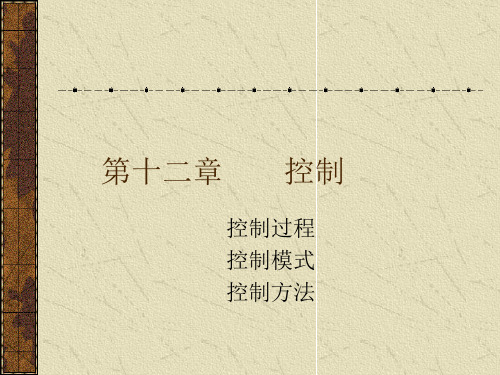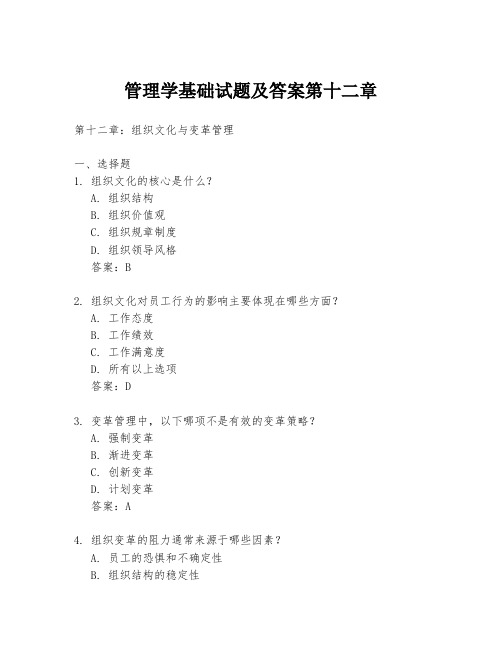管理学第十二章
《管理学》第十二章重难点笔记

《管理学》第十二章重难点笔记第十二章激励12.1 复习笔记【知识框架】【重点难点归纳】一、激励原理1.激励的概念与对象(1)激励的概念激励(motivation)主要指人类活动的一种内心状态,它通常是和动机连在一起的。
美国管理学家罗宾斯把动机定义为个体通过高水平的努力而实现组织目标的愿望,而这种努力又能满足个体的某些需要。
一般而言,动机是指为满足某种需要而产生并维持行动,以达到目的的内部驱动力。
无论是激励还是动机,都包含三个关键要素:努力、组织目标和需要。
(2)激励的对象激励的对象主要是人,或者准确地说,是组织范围中的员工或领导对象。
2.激励与行为激励是组织中人的行为的动力,而行为是人实现个体目标与组织目标相一致的过程。
无激励的行为,是盲目而无意识的行为;有激励而无效果的行为,说明激励的机理不合理。
通过激励促成组织中人的行为的产生,取决于某一行动的效价和期望值。
效价是指个人对达到某种预期成果的偏爱程度,或某种预期成果可能给行为者带来的满足程度;期望值则是某一具体行动可带来某种预期成果的概率。
激励力、效价和期望值之间的相互关系用下式来表示:激励力=效价×期望值。
3.激励产生的内因与外因激励产生的根本原因,可分为内因和外因。
内因由人的认知知识构成,外因则是人所处的环境,从激励基础上人的行为可看成是人自身特点及其所处环境的函数。
4.需要的管理学意义需要对管理学的领导职能来说,是能否发挥管理作用并影响组织成员完成组织目标的前提。
从领导方式看,需要是领导者指挥下属和鼓励下属的行为基础。
二、激励的需要理论1.需要层次论该理论是由美国社会心理学家亚伯拉罕·马斯洛提出来的,也称为马斯洛需要层次论。
(1)马斯洛将人的需要分为五个层次①生理的需要。
它是最基本的需要。
如衣、食、住、行等。
②安全的需要。
保护自己免受身体和情感伤害的需要。
③社交的需要。
包括友谊、爱情、归属及接纳方面的需要。
这主要产自于人的社会性。
管理学原理第十二章控制

1 客观准确性
2 经济性
3 灵活多变性
4 全局性
5 有针对性
6 预见性
控制过程与模式
• 一 控制过程
确立控 制标准
制控 控 定制 制 控重 对 制点 象 标 准
衡量实 际成效
系建 衡 统立 量
信成 息绩 反 馈
纠正偏差
选确 找 择立 出 纠纠 原 偏编 因 措对 施象
二 控制模式
修订标准/目标
量度实际绩效
第十二章 控制
控制过程 控制模式 控制方法
控制的定义与特性
一 控制的概念
控制是指人们根据给定的条件和预定的 目的或考核标准;通过改变和创造条件;以 调整行动和计划;纠正偏差;使事物发展按 预定方向发展 控制在管理中的作用有两方面: 1 检验作用 2 调整作用;
二 控制的类型
1 根据时机 对象和目的的不同;可以把控制划 分为预先控制 现场控制过程控制和成果控 制事后控制等三种类型
输入
工作过程
输出
前馈控制
同期控制
反馈控制
2 根据控制源的不同可划分为正式组织控 制 群体控制和自我控制三种类型
3 根据控制信息的性质不同可划分为反馈 控制和前馈控制两种类型
4 根据控制的手段不同可划分为直接控制 和预防性控制两种
三 有效控制的特性
•
Байду номын сангаас
要使控制系统发挥作用;取得预期的成效;
控制系统应具备以下特性
2 管理审计
其方法是利用公开记录的信息;从反映管理绩 效及其影响因素的若干方面;将与同行业其他或 其他行业的著名进行比较;以判断经营与管理的 健康程度;从而进行审计控制的一种有效控制 方法
三 作业控制
管理学第十二章创新

4
创新与维持的关系及作用
• 管理的维持职能便是要严格地按预定的规 划来监视和修正系统的运行,尽力避免各 子系统之间的摩擦,或减少因摩擦而产生 的结构内耗,以保持系统的有序性 • 管理的创新职能是为适应系统内外变化而 进行的局部和全局的调整
5
• 作为管理的两大基本职能,维持与创新对 系统的生存发展都是非常重要的,它们相 互联系、不可或缺 • 创新是维持基础上的发展,而维持是创新 的逻辑延续;维持是为了实现创新的成果, 而创新则是为了更高层次的维持提供依托 和框架 • 任何管理工作,都应围绕着系统运转的维 持和创新而展开 • 卓越的管理是实现维持与创新最优组合的 管理
22
• 两种创新水平的选择: • 先发制人:在行动上“先人一步”,目的 是在市场竞争中“高人一筹”—领先战略
–优点
• • • • • 给企业带来良好的声誉 使企业占据有利的市场地位 使企业进入最有利的销售渠道 使企业获得有利的要素来源 使企业获得高额的垄断利润
–不足
• 要求高额的市场开发费用 • 需求的不确定性 • 技术的不确定性
第十三章
管理创新
1
第一节 创新职能
• 在英文中,创新(Innovation)一词来源于拉 丁文“innovate”,意思是更新、改变或创造 新的东西 • 第一个从经济学角度提出创新理论的是哈 佛教授约瑟夫•熊彼特,1912年在专著《经 济发展理论》中提出创新理论 • 他认为创新是:建立一种新的生产函数, 即实现生产要素和生产条件的一种新的组 合。其包括:
4、组织机构和结构创新
• 企业系统的正常运行,既要求具有符合企 业及其环境特点的运行制度,又要求具有 与之相应的运行载体,即合理的组织形式 • 机构:是指企业在构建组织时,根据一定 的标准,将那些类似的或为实现同一目标 有密切关系的职务或岗位归并到一起,形 成不同的管理部门,它主要涉及管理劳动 的横向分工的问题 • 结构:与各管理部门之间,特别是与不同 层次的管理部门之间的关系有关,它主要 涉及管理劳动的纵向分工问题
《管理学》课件第十二章沟通

第二节 沟通的分类及特点 (续)
正式沟通与非正式沟通
– 正式沟通 通过组织明文规定的渠道进行信息传递和 交流
• •
•
优点是:沟通效果好,比较严肃,约束力强,易于保密, 可以使信息沟通保持权威性 缺点在于:由于靠组织系统层层传递,要遵照既定的程 序,沟通的成本相对较高,而且沟通的速度慢,也存在着 信息失真的可能 组织中存在着上行沟通、下行沟通和交叉沟通三种形式 • 上行沟通是指下级的意见、信息向上级反映 • 下行沟通是指自上而下的沟通,是信息从高层次成员朝低层
• • • •
单线传递 闲谈传递 随机传递 集群传递
是指信息由一人转告另一个人,实施单线传播 以某一人为中心,将信息传播给其他人,发布“独家新闻 这种传递模式的最大特点是无事先指定信息接收者 即在沟通过程中,可能有几个中心人物,信息由中心人物 向外扩散,而且有某种程度的弹性
F C E B
D E A
•
• •
第二节 沟通的分类及特点 (续)
人际沟通与组织沟通(续)
– 组织沟通 组织内部人与人、部门与部门之 间,以及组织与外部进行的信息交流或传递 活动,包括组织中沟通的各种方式、网络和系 统等
• •
正式沟通、上行与下行、平行沟通 组织沟通与人际沟通最大的差别是人际沟通主要 体现一种平等关系,而组织沟通更多的形式是上 下层级之间的关系
•
人与人之间的沟通不同于其他沟通过程的特殊性,就在于 人之间是通过语言和其他的媒介形式进行信息传递和思想 交流 沟通必须有内容,而其内容必定是双方的接触、联系并产 生相互影响 沟通的目的是促进人们之间的了解与合作,但是,由于沟 通会出现特殊障碍,这种障碍不仅是由于信息渠道的失真 或错误,而且是人特有的心理障碍
管理学第十二章

1.不采取任何行动
2.改进实际工作 3.修订标准 管理学
三、控制类型
根据控制的时间点,可以将控制划分为三种类型:前馈控 制、同期控制和反馈控制。
管理学
四、控制系统
在组织中,管理者为了实现组织目标,希望通过建立适当的控制
系统实现目标。
根据美国加利福尼亚大学威廉姆〃奥奇的研究,组织的控制系统 可以分为三种类型,即官僚控制、市场控制和派系控制。
立有效的组织控制系统。
管理学
二、控制的过程
组织实施控制的过程一般包括四个步骤:
(1)设定绩效指标体系和衡量标准; (2)衡量实际行为和实际绩效;
1.直接观察 2.统计报告 3.口头报告
4.书面报告
(3)将实际绩效与绩效标准进行比较; (4)对比较后产生的差距采取行动。
构中的位置和级别、组织的分权程度、组织文化、活
动的重要性
组织的规模与采取有效控制的手段和方法有密切的关系。 因员工在组织结构中的位置和级别不同,即职位和层次 不同,对其采取的控制标准是多重的,而且标准也不同。 组织的分权程度同样也影响控制的有效性。 组织文化同样影响控制的有效性。 活动的重要性对控制也产生影响。 管理学
一个组织不会仅采用一种控制系统,而是基于不同控制系统的
优势和劣势在组织内使用多种控制系统对组织实施有效控制。
(一)官僚控制系统依赖于员工有良好的行为规范、描述清晰的工作规则、 严格而有效的管理机制。 (二)市场控制系统是一种使用市场标准或其他绩效考核标准对系统内各 个部门进行控制的方法。 (三)派系控制系统(小集团控制或文化控制)是指通过在组织内建立共 同的文化观念来实现对员工的控制 管理学
(5)有效控制应该被员工所理解并接受。
管理学_第12章

• 请论述在管理过程中有哪些基本要素需要 进行有效控制? 进行有效控制?
三、纠正偏差
1. 改进工作方法 2. 改进领导方法 3. 调整计划或标准
第三节 控制方法和原则
一、常用的控制方法
1. 预算控制 2. 生产控制 3. 其他控制方法
二、有效控制的原则
• • • • • 适应性原则 及时性原则 灵活性原则或弹性原则 经济性原则 匹配性原则
【本章联系实际讨论题】 本章联系实际讨论题】
第十二章 控 制
第一节 控制的目标与类型
一、控制的含义与重要性
1. 控制的含义 • • • • • 控制的目标体系 控制的主体 控制的对象 控制的手段 控制的反馈系统
2.Βιβλιοθήκη 控制的重要性(1)控制是使组织适应环境的重要保证 (2)控制是分权管理的重要手段 (3)控制是防范能力差异影响的重要方法
二、控制的目标与特点
三、控制的基本类型
3. 根据控制的内容不同,可以将控制划分 为预算控制、质量控制、人事管理控制、 库存控制和进度控制五类
第二节 控制的过程
一、确立标准
1. 控制标准的分类 2. 确定控制标准应注意的问题
(1)明确控制对象 (2)明确控制重点 (3)建立标准体系
二、衡量绩效
衡量工作成绩的过程中应注意以下几个 问题 1. 检测标准的合理性 2. 确定衡量频度和建立信息管理系统
1. 控制的目标 2. 控制的特点
三、控制的基本类型
1. 根据信息获取的方式和时点的不同,可 以将控制划分为: 以将控制划分为:
(1)前馈控制 (2)现场控制 (3)反馈控制
三、控制的基本类型
2. 根据问题的重要性和影响程度的不同, 可以将控制划分为: 可以将控制划分为: (1)战略控制 (2)绩效控制 (3)任务控制
《管理学》第十二章 沟通

Page 34
管理学
Page 28
管理学
甲:常言道:心宽体胖,您这样魁梧,真让我们羡慕。 乙:别提了,成天减肥,却越来越肥。 甲:肥是一种美,你看曹操、董卓、袁世凯这些盖古
人物,哪个不肥。何况作为经理,成天忙于应酬,吃 吃喝喝,能不肥吗?我等想肥还肥不起来呢。 乙:??
Page 29
管理学
Page 30
管理学
个人手中仍然还是一个苹果。
你有一种思想,我有一种思想,彼此交流思想, 那么我们每个人便有了两种思想。”交换ຫໍສະໝຸດ 共享Page 7管理学
沟通的实质
人不能不沟通 所有人类的沟通形态均包含共同的因素 沟通是一个符号象征的过程 每一个符号并没有固定的意义 沟通只有在人们使用一套共同符号系统时才能发生 非口头语言在人们沟通时起着十分重要的作用 人们的注意力具有高度的选择性 人们运用歪曲信息或逃避的方式来保持知觉的平衡
自上而下的沟通:口头沟通和书面沟通 自下而上的沟通 交叉沟通:横向沟通与斜向沟通
Page 14
管理学
Page 15
管理学
非正式沟通
非正式信息沟通是指不按照正式的、组织所规定 的沟通渠道与沟通方式,或不以工作职务的身份 所进行的对组织内、外部的人际沟通。
Page 16
管理学
Page 17
3、来自于环境的原因 团体气氛不和谐 渠道不通畅
Page 24
管理学
习惯性防卫
“习惯性防卫是根深蒂固的习惯,用来 保护自己或他人免于因为我们说出真正的 想法而受害,或感到威胁。”
彼得·圣吉
Page 25
管理学
Page 26
管理学
Page 27
管理学
沟通的改善
管理学第十二章

(4)大多数人都具备正确决策的能力
第三节 激励的过程理论
一、期望理论 美国心理学家弗鲁姆(1964年)认为:只要当
人们预期到某一行为能给个人带来有吸引力的 结果时,个人才会采取特定的行动。根据这个 理论,人们在工作中的努力程度是效价和期望 值的乘积,即: M=V×E 式中:M-激发力量、V-效价、E-期望值 所谓效价,是指一个人对某项工作及其结果 ( 可实现的目标 ) 能够给自己带来满足程度的评 价,即对工作目标有用性(价值)的评价; 所谓期望值,是指人们对自己能够顺利完成这 项工作可能性的估计,即对工作目标能够实现 概率的估计。
(二)安全的需要
一是现在的安全需要;。 就是要求自己现在的社会生活的各个方面
均能有所保证,如就业安全、生产过程中 的劳动安全、社会生活中的人身安全等等; 二是对未来的安全需要。就是希望未来的 生活能有所保障。如病、老、伤、残后的 生活保障等。
安全
安全
安全
公开抢劫
不公平的情况又有两种:
一种是Op/Ip<Os/Is,
另一种是Op/Ip>Os/Is。
前者是一种对自己不利的不公平,后者是
一种对自己有利的不公平。 如果组织成员感到分配是公平的,则会 在下一时期的工作中保持较高的工作积极 性,或完善自己的行为; 如果比较的结果是第一种情况的不公平, 则会感觉到,自己辛辛苦苦干,还不如别 人轻轻松松混,下次再也不这么‘‘卖力” 了!
3、对社交的需要.
社交需要是指希望和他人建立亲近和睦的
关系的愿望。有高度社交需要的人其特征 如下: (1) 寻求建立并保持和他人的友谊和亲密 的感情关系; (2)希望获得他人对自己的好感; (3) 乐于参加各种社交活动,以寻求知心 朋友 (4)乐于帮助和安慰危难中的伙伴。 实际上,人们在不同程度上都有以上三种 动机,但各种需要的强弱程度则因人而异。
管理学第十二章 激励理论

麦克兰对成就需要和工作绩 效的关系进行了十分有说服 力的推断。 力的推断。
高成就需要者喜欢能独立负责、 高成就需要者喜欢能独立负责、 可以获得信息反馈和中度冒险的 工作环境。在这种环境下, 工作环境。在这种环境下,他们 可以被高度激励。不少证据表明, 可以被高度激励。不少证据表明, 高成就需要者在企业中颇有建树。 高成就需要者在企业中颇有建树。
赫兹伯格提出, 赫兹伯格提出,影响人们行为 的因素有两类:保健因素和 的因素有两类:保健因素和激励 因素。 因素。 保健因素是那些和人们的不满 保健因素是那些和人们的不满 情绪有关的因素。 情绪有关的因素。 激励因素和工作内容有关 和工作内容有关。 激励因素和工作内容有关。 这两类因素与员工对工作的满 意度之间的关系如下图: 意度之间的关系如下图:
(六)公平理论(亚当斯)
察觉到的比率比较
所得A 付出A 所得B 付出B Nhomakorabea员工的评价
不公平
说明: *参照对象 *不公平时的反应
付出指一个人对组织所作的贡 付出 指一个人对组织所作的贡 它包括努力、 时间、 才能、 献 , 它包括努力 、 时间 、 才能 、 额外的投入和良好的品格等。 额外的投入和良好的品格等。 所得指在工作中所得到的 指在工作中所得到的, 所得 指在工作中所得到的 , 包 括工资、 福利、 满意度、 安全感、 括工资 、 福利 、 满意度 、 安全感 、 工作分配、奖励或惩罚等。 工作分配、奖励或惩罚等。
迪娜十分惊讶。她的大多数员工不到30岁。而年 均收入为35000美元,这已超过本镇从事相似工作的员 工收入的20%。对于她自己来说,如果年收入已达 35000美元,再让她在钱和休闲时间之间进行选择的话, 她毫无疑问选择后者。 迪娜为此事召开了全公司会议听听大家意见。她 问大家“多少人赞成四天工作制?”6只手举了起来。 “多少人赞成5天工作制而额外获得4000美元的奖金”。 另外的6只手举了起来。
管理学基础试题及答案第十二章

管理学基础试题及答案第十二章第十二章:组织文化与变革管理一、选择题1. 组织文化的核心是什么?A. 组织结构B. 组织价值观C. 组织规章制度D. 组织领导风格答案:B2. 组织文化对员工行为的影响主要体现在哪些方面?A. 工作态度B. 工作绩效C. 工作满意度D. 所有以上选项答案:D3. 变革管理中,以下哪项不是有效的变革策略?A. 强制变革B. 渐进变革C. 创新变革D. 计划变革答案:A4. 组织变革的阻力通常来源于哪些因素?A. 员工的恐惧和不确定性B. 组织结构的稳定性C. 管理层的反对D. 所有以上选项答案:D5. 以下哪项不是组织文化与组织变革的关系?A. 组织文化可以促进变革B. 组织文化可以阻碍变革C. 组织变革可以改变组织文化D. 组织文化与组织变革无关答案:D二、简答题1. 简述组织文化的定义及其对组织的影响。
答:组织文化是指一个组织内部共享的价值观、信仰、习惯、行为规范和象征等的总和。
它对组织的影响主要体现在塑造员工的行为模式、决策方式以及组织的整体氛围,进而影响组织的绩效和竞争力。
2. 描述变革管理的三个主要阶段。
答:变革管理的三个主要阶段包括:(1)准备阶段,识别变革需求并制定变革计划;(2)实施阶段,执行变革计划并监控变革过程;(3)巩固阶段,评估变革效果并确保变革成果的持续。
三、案例分析题案例:某公司决定引入新的工作流程以提高效率。
然而,一些员工对此表示担忧,担心新流程会取代他们的工作。
请分析该公司在变革管理中可能面临的挑战,并提出解决方案。
答:该公司在变革管理中可能面临的挑战包括员工的抵抗、沟通不畅、变革计划的不完善等。
解决方案可以包括:(1)加强与员工的沟通,解释新流程的好处和必要性;(2)提供培训和支持,帮助员工适应新流程;(3)确保变革计划的可行性和灵活性,以适应不同员工的需求;(4)建立反馈机制,及时调整变革策略。
结束语:通过本章的学习,我们了解到组织文化对组织行为和变革管理的深远影响。
周三多管理学 第十二章 控制

控制类型
1.前馈控制 1.前馈控制
亦称预先控制或事前控制,是实际组织活动 亦称预先控制或事前控制, 开始之前进行的控制。前馈控制以未来为导向, 开始之前进行的控制。前馈控制以未来为导向, 在工作之前对工作中可能产生的偏差进行预测 和估计,采取防范措施, 和估计,采取防范措施,以便在实际偏差出现 之前, 之前,管理者就能运用各种手段对可能产生的 偏差进行纠偏。 偏差进行纠偏。
前馈控制的显著优点 前馈控制是在工作开始之前进行的控制, ①前馈控制是在工作开始之前进行的控制, 因而防患于未然, 因而防患于未然,避免事后控制无能为力 的弊端。 的弊端。 ②前馈控制是针对某项计划行动所依赖的条 件进行的控制,不针对具体人员, 件进行的控制,不针对具体人员,不会造 成心理冲突,易于被员工接受并付诸实施。 成心理冲突,易于被员工接受并付诸实施。
控制理论
1. 基本理论 a. 任何系统都是由因果关系链连接在一起的元素 的集合。元素之间的这种关系叫耦合。 的集合。元素之间的这种关系叫耦合。控制论就 是研究耦合运行系统的控制和调节的 b. 为了控制耦合系统的运行,必须确定系统的控 为了控制耦合系统的运行,必须确定系统的控 制标准。 制标准。系统的标准 Z 是不断变化的某个参数 S 的函数。 的函数。即:Z = f ( S ) c. 可以通过对系统的调节来纠正系统输出与标准 之间的偏差, 值Z之间的偏差,从而实现对系统的控制 之间的偏差
事后控制不如事中控制, 事后控制不如事中控制,事中控制不如事 前控制, 前控制,可惜大多数的事业经营者均未能 体会到这一点, 体会到这一点,等到错误的决策造成了重 大的损失才寻求弥补。弥补得好, 大的损失才寻求弥补。弥补得好,当然是 声名鹊起,但更多的时候是亡羊补牢, 声名鹊起,但更多的时候是造 发动机
《管理学》教学课件 第十二章

各种常见的沟通渠道比较
沟通渠道
举例
优点
缺点
口头 书面 非语言
交谈、讲座、讨论会、电话
报告、备忘录、信件、文件、 内部期刊、布告
声,光信号(红绿灯、警铃、 旗语、图形、服饰标志),体 态手势,肢体动作,表情,语 调
快速传递、快递反馈、 信息量很大
持久、有形,可以核实
信息意义十分明确。内 涵丰富,灵活
传递中经过层次愈多, 信息失真愈严重,核实 愈困难
有效沟通一般具备以下特征: 〔1〕有效沟通的信息具有真实性。 〔2〕有效沟通的信息具有完整性。 〔3〕有效沟通的主体具有共识性。 〔4〕有效管理沟通的代码具有相同性。 〔5〕有效沟通的及时性。 〔6〕有效沟通的渠道是适当的。 〔7〕有效沟通方式具有灵活性。 〔8〕有效沟通的结果和目标具有一致性。
第十二章 沟 通
第十二章 沟 通
12
一、正式沟通
〔一〕正式沟通的类型
第十二章 沟 通
13
〔二〕正式沟通网络
由组织正式沟通的3种形式可组合成组织信息传递的多种模式,这些模式称为组织信 息沟通网络,它说明了在一个组织中,信息是怎样传递或交流的。正式沟通网络的根本形 式有五种:链式、轮式、Y式、环式和全通道式。
组织正式沟通网络
效率低、缺乏反馈
传送距离有限。界限含 糊。只可意会,不可言 传
电子媒介
传真、闭路电视、计算机网络、 电子邮件
快速传递、信息容量大、 远程传递、一份信息同 时传递多人、廉价
单项传递,电子邮件可 以交流,但看不到表情
第十二章 沟 通
8
二、沟通的过程
3.信息接收者
• 信息接收者先接收到传递而来的“共同语言”或“信号”,然后按照相应的办法将此 还原为自己的语言,即“译码”,这样就可以理解了,当信息接收者需要将他的有关 信息传递给原先的信息发送者时,此时他自己变为了信息的发送者。
管理学复习-第十二章沟通联络.

第十二章沟通联络第一节沟通联络的概念、目的和作用一、沟通联络的概念沟通联络,简称沟通,是指将某一信息传递给客体或对象,以期取得客体或对象做出相应反应的过程。
根据概念,沟通包含三个含义:(一)沟通是双方的行为,有三种表现形式1.人—人之间的沟通。
2.人—机之间的沟通。
3.机—机之间的沟通人—人之间的沟通有其不同于其它沟通的特殊性:①人—人之间的沟通主要是通过语言(或语言的文字形式)来进行的。
②人与人之间的沟通不仅是消息的交流,而且包括情感、思想、态度、观点的交流。
③在人与人之间的沟通过程中,心理因素有着重要意义。
④在人与人之间的沟通过程中,会出现特殊的沟通障碍。
(二)沟通是一个过程,完整的沟通过程包括七个环节。
1.沟通主体——信息发出者2.编码3.媒体——沟通渠道4.沟通的客体——信息接收者5.译码6.作出反应7.反馈(三)编码、译码和沟通渠道是沟通联络过程取得成效的关键环节。
它始于主体发出信息,终于得到反应。
二、沟通联络的目的和作用杨P301(一)目的:促进变革,即按有利于组织的方向左右组织的行动。
(二)作用1.使组织中的人们认清形式新来的人员下级主管人员2.使决策更加合理和有效3.稳定员工的思想情绪,统一组织行动第二节沟通联络的方式和方法一、沟通联络的方式(一)正式沟通与非正式沟通正式沟通一般指在组织系统内,依据组织明文规定的原则进行的信息传递与交流。
这类沟通主要运用组织机构和权力进行。
优点:沟通效果好,比较严肃,约束力强,易于保密,可以使信息沟通保持权威性。
缺点:刻板(依靠组织系统层层传递),沟通速度很慢,存在信息失真或扭曲的可能。
适用:重要消息和文件的传达;组织的决策。
非正式沟通是在正式沟通渠道之外进行的信息传递或交流。
优点:沟通形式不拘,直接明了,速度很快,容易及时了解到正式组织难以提供的“内幕新闻”。
缺点:难于控制,传递的信息不确切,容易失真;可能导致小集团、小圈子,影响组织的凝聚力和人心稳定。
周三多管理学第十二激励

管理方式:X理论 ➢ 管理者关心的是工作效率和完成任务 ➢ 管理者职能是计划、组织、指挥、监督 ➢ 管理者用职权发号施令使下属服从 ➢ 不考虑感情上和道义上对人的尊重 ➢ 强调严密的组织、规则、制度 ➢ 用金钱收买下属的效力和服从
MG2-33
四、X、Y理论
管理方式:Y理论 ➢ 管理者的任务是创造使人能发挥才能的工作
导入案例
郝新生的故事告诉我们,当我们决定采取某 项措施去激励员工时,我们要看我们给予他的是 不是员工所迫切需要的,只有当员工所得最能满 足自己需要时,激励的效果才是最佳。
这个案例几乎所有企业管理者都会遇到。只 有那些不断研究并发现员工需要和愿望,并努力 调整自己的激励方式,激发员工付出最大努力的 管理者,才是成功的管理者。
行为动机的实质 需要是人类行为的导源 需要是人类内在的、天生的、下意识存
在的 满足了的需要不再是激励因素
二、双因素理论(保健—激励理论)
双因素理论是1959年由美国的赫兹伯格提出的 赫兹伯格,美国心理学家,重点研究组织中个人与工作的关 系问题。 保健因素:与人们的不满情绪有关的因素,如公司的政策、 管理和监督、人际关系、工作条件等。 激励因素:与人们的满意情绪有关的因素。主要包括工作 表现机会和工作带来的愉快,工作上的成就感,奖励,期 望,责任感。
成功标准、掌握复杂的工作以及超过别人; (2)依附的需要:指渴望结成紧密的个人关系、回避冲突
以及建立亲切的友谊; (3)权力的需要:指渴望影响或控制他人、为他们负责以
及拥有高于他人的职权的权威。
成就需要论
成就的需要
权力的需要
成就需 要论
依附的需要
MG2-30
四、X、Y理论
道格拉斯·麦克雷戈(Douglas McGregor) ,美国行为科学家
管理学-管理创新

我国管理学者芮明杰教授将管理创新定义为创造一种新的或更有效的 资源整合范式,这种范式可以是新的有效整合资源以达到企业目标的 全过程管理,也可是某方面的细节管理,至少可以包括以下五个方面 情况:(1)提出一种新的经营思路并加以有效实施,如果经营思路可 行就是一种管理创新;(2)设计一个新的组织结构并使之有效运作; (3)提出一个新的管理方式、方法,它能提高生产效率,协调人际 关系或能更好地激励员工;(4)设计一种新的管理模式;(5)进行 一项制度创新。
以及两者的组合)或者通过制定新的定价 模型开拓新业务。(2) 在企业层面,可以通 过重新定义企业的边界,改变企业结构或 者企业在价值链中的地位。(3) 在行业层面, 可以通过重新定义现有行业,对行业价值 链进行改造。
第二节 管理创新的过程
一、管理创新的基本过程 管理创新是知识经济对管理提出的必然要求,也是经济增
改变游戏规则战略(先你而动的战略),采取这种战略的 企业主动出击,改变商业游戏规则,使游戏规则向着对已 有利的方向发展。
2.组织创新
组织创新是组织的形态和结构方面的创新。
近年来,组织呈现出虚拟化、分立化、柔性化和 学习化的趋势,要求管理者适应环境的变化,选 择合适的组织形态和组织结构。
知识经济时代,应树立“知本观念”,加强知识 管理和信息管理,加快实行由传统的资本和劳动 力投入为主向知识投入为主转变;由非科技投入 主体向科技投入主体转变;由等级管理向网络管 理与等级管理结合转变;由单纯运用技术知识向 综合运用各种知识转变;由单纯的竞争向竞争与 合作转变。
- 1、下载文档前请自行甄别文档内容的完整性,平台不提供额外的编辑、内容补充、找答案等附加服务。
- 2、"仅部分预览"的文档,不可在线预览部分如存在完整性等问题,可反馈申请退款(可完整预览的文档不适用该条件!)。
- 3、如文档侵犯您的权益,请联系客服反馈,我们会尽快为您处理(人工客服工作时间:9:00-18:30)。
Styles
– Leader-member relations – Task structure – Position power
Styles (determined by least-preferred co-worker questionnaire) 最难共事者问卷
– Task-oriented – Relationship-oriented
Telling: high task-low relationship leadership Selling: high task-high relationship leadership Participating: low task-high relationship leadership Delegating: low task-low relationship leadership 授权
University of Iowa Studies
Three leadership styles:
– Autocratic style: centralized authority, low participation – Democratic style: involvement, high participation, feedback – Laissez faire style: hands-off management (放任型)
9th ed.
STEPHEN P. ROBBINS MARY COULTER
Chapter Twelve Leadership
© 2007 Prentice Hall, Inc. All rights reserved.
1
Overview of Chapter Twelve
Managers vs. Leaders Leadership Theories Traits Behavioral
6
Managerial Grid Appraises leadership styles using two dimensions:
– Concern for production – Concern for people
Places managerial styles in five categories:
Ohio State University Studies
Two behavioral dimensions:
– Initiating structure: the role of the leader in defining his role and the roles of group members(定规维度) – Consideration: the leader’s mutual trust and respect for group members’ ideas and feelings(关怀维度)
• Leadership
The process of influencing a group to achieve goals return
3
2. Leadership Theories
2.1 Traits 2.2 Behaviors 2.3 Situations
return
4
2.1 Trait Theories of Leadership (1920s-30s)
Current Views on Leadership Transactional & Transformational Charismatic & Visionary Team Leader Current Leadership Issues Managing Power Developing Trust Empowering Employees
13
Leader Participation Model
Posits that leader behavior must be adjusted to contingencies for determining follower participation in decision making. Contingencies
– Ohio State University – University of Michigan – University of Iowa – Managerial Grid
Contingency
– The Fiedler Model – Hersey & Blanchard’s Theory – Leader Participation Model – Path-Goal Model
►
2
1. Managers versus Leaders
Managers Are appointed to their position. Can influence people only to the extent of the formal authority of their position. Should ideally be leaders. Leaders Are appointed or emerge from within a work group. Can influence other people for reasons beyond formal authority, and have managerial authority. Do not necessarily have the capabilities to be managers, e.g. plan, organize, and control.
10
Findings of the Fiedler Model
11
Hersey and Blanchard’s Situational Leadership Theory
Argues that successful leadership is achieved by selecting the right leadership style which is contingent on the level of the followers’ readiness(成熟度). (
Assumes a person’s leadership style is fixed, regardless of situation So ways to improve leader effectiveness
– Bring new leader, or – Change situation
– – – – – Decide Consult individually Consult group Facilitate 促进 Delegate
14
Leadership Styles in the Vroom Leader Participation Model
• Decide: Leader makes the decision alone and either announces or sells it to group. • Consult Individually: Leader presents the problem to group members individually, gets their suggestions, and then makes the decision. • Consult Group: Leader presents the problem to group members in a meeting, gets their suggestions, and then makes the decision. • Facilitate: Leader presents the problem to the group in a meeting and, acting as facilitator, defines the problem and the boundaries within which a decision must be made. • Delegate: Leader permits the group to make the decision within prescribed limits.
Drive Desire to lead Honesty and integrity Self-confidence Intelligence Job-relevant knowledge Extraversion
return
5
2.2 Behavioral Theories of Leadership (1940s-60s)
– Impoverished management – Task management – Middle-of-the-road management – Country club management – Team management
No answer to “what makes an effective leader”, only framework of leadership style
7
The Managerial Grid
return
8
2.3 Contingency Theories of Leadership
The Fiedler Contingency Model Hersey and Blanchard’s Situational Leadership Theory Leader Participation Model Path-Goal Model
